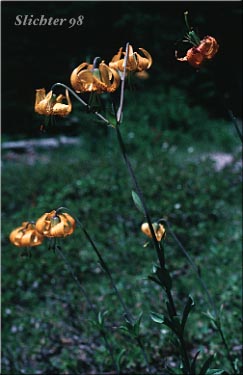 Lilium columbianum
from the Ape Canyon Trail, Mt. Helens National Monument...............July 13,
1996.
Lilium columbianum
from the Ape Canyon Trail, Mt. Helens National Monument...............July 13,
1996.
The tiger lily, sometimes called the Columbia lily, is a very attractive perennial wildflower arising from an ovoid bulb having several thick, ovate-lanceolate scales, about two to 3 cm long. The stem is stiff and erect, from 60 to 120 cm in height. The leaves are found on the stems. These are often whorled, but occasionally are found scattered along the stem. The individual leaves are parallel veined, smooth margined, and lanceolate or elliptic in shape. They measure from 4-10 cm long and up to 3.5 cm wide.
The flowers are clustered at the top of the stem in an open raceme of several to twenty flowers. Individual flowers 6 tepals (petals and sepals are similar) which are a bright yellowish-orange to reddish-orange color, with numerous deep red or purple spots. The individual tepals measure from 4-6 cm long and 8-12 mm wide, and are strongly curved upward, opening up the middle of the flower so that the stamens with their pollen-tipped anthers dangle below. The fruit is an erect, cylindrical capsule from 3-4 cm long.
Tiger lilies are found in a variety of northwest habitats, from coniferous forests, shrubby thickets, or in grassy meadows. It can be found from sea level to 6000 feet.
Tiger lilies are found from southern British Columbia south along both sides of the Cascade Mts. to northern California. This beautiful wildflower is found eastward to northern Idaho, and southward into Nevada.
In the Columbia River Gorge it may be found between the elevations of 100'-4500' from near Troutdale, OR east to near the Klickitat River.